HLSC122: Critical Appraisal of Drug Use at Music Festivals
VerifiedAdded on 2022/11/15
|7
|1698
|346
Report
AI Summary
This report presents a critical appraisal of the research paper "Music festival attendees’ illicit drug use, knowledge and practices regarding drug content and purity: a cross-sectional survey" by Day et al. (2018). The report begins with an introduction to the prevalence of illicit drug use, particularly among music festival attendees, and the potential harms associated with it. Part A of the report critically appraises the research paper, examining authorship, research questions, design, methods, and results. The study, which surveyed 642 music festival attendees, found high rates of illicit drug use and positive attitudes toward drug checking services. Part B applies the research findings to a case scenario involving parental concerns about drug testing at music festivals, discussing enablers and barriers to implementing the research in practice. The report concludes by summarizing the study's strengths and limitations, emphasizing the potential of drug checking and harm reduction strategies to influence behavior. The report also highlights the need for further research to fully assess the impact of drug checking in the context of music festivals and the importance of parental involvement.
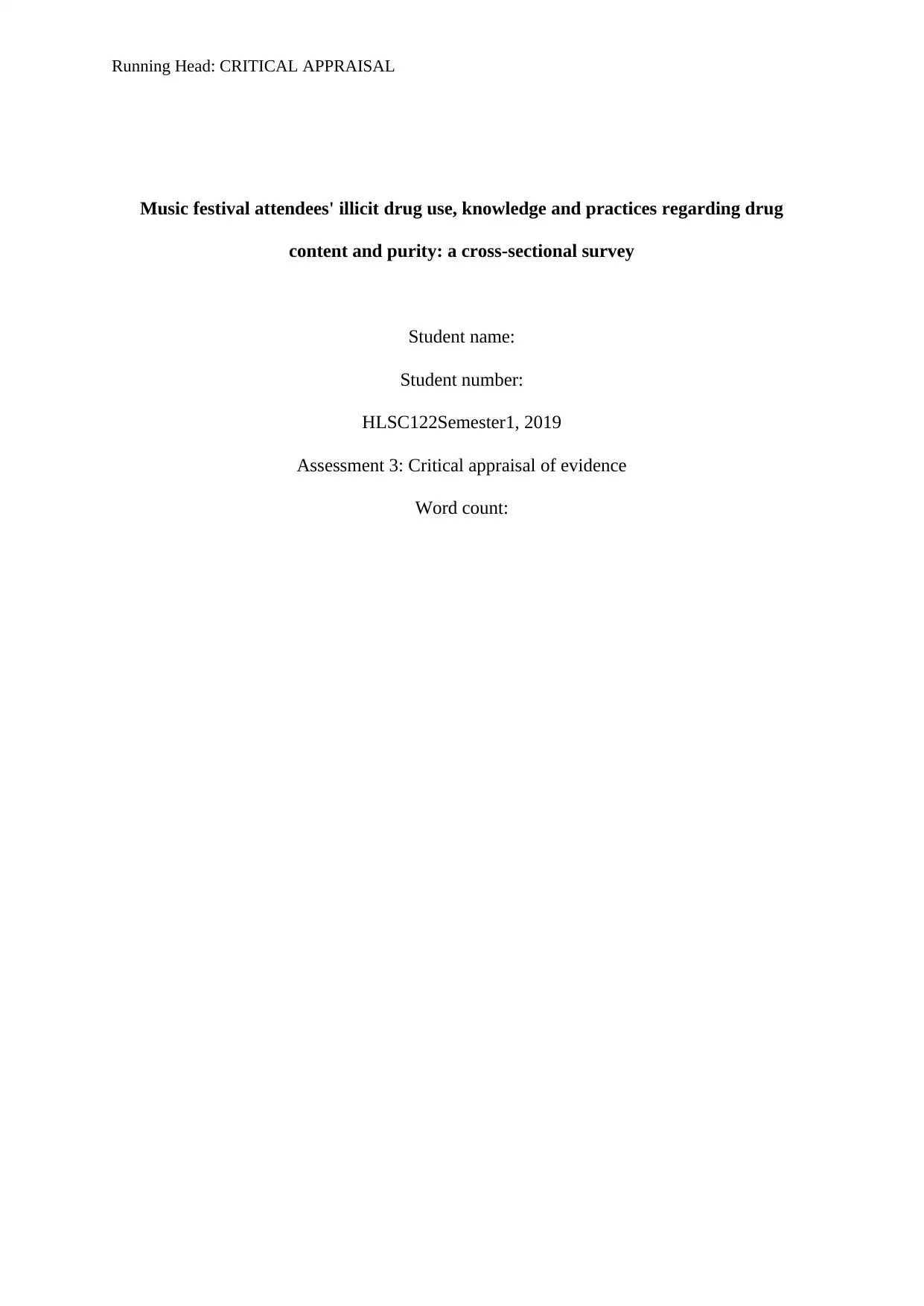
Running Head: CRITICAL APPRAISAL
Music festival attendees' illicit drug use, knowledge and practices regarding drug
content and purity: a cross-sectional survey
Student name:
Student number:
HLSC122Semester1, 2019
Assessment 3: Critical appraisal of evidence
Word count:
Music festival attendees' illicit drug use, knowledge and practices regarding drug
content and purity: a cross-sectional survey
Student name:
Student number:
HLSC122Semester1, 2019
Assessment 3: Critical appraisal of evidence
Word count:
Paraphrase This Document
Need a fresh take? Get an instant paraphrase of this document with our AI Paraphraser
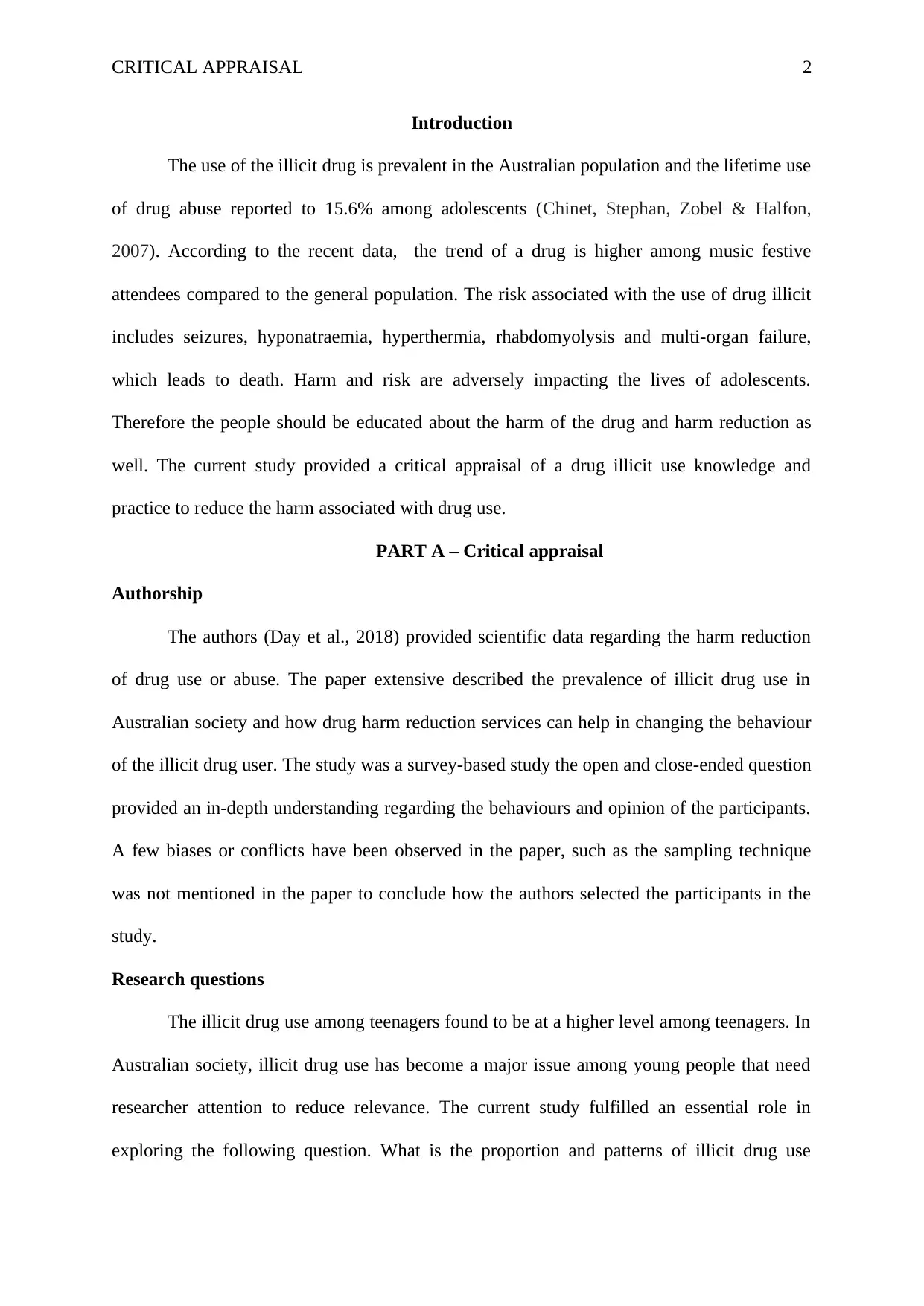
CRITICAL APPRAISAL 2
Introduction
The use of the illicit drug is prevalent in the Australian population and the lifetime use
of drug abuse reported to 15.6% among adolescents (Chinet, Stephan, Zobel & Halfon,
2007). According to the recent data, the trend of a drug is higher among music festive
attendees compared to the general population. The risk associated with the use of drug illicit
includes seizures, hyponatraemia, hyperthermia, rhabdomyolysis and multi-organ failure,
which leads to death. Harm and risk are adversely impacting the lives of adolescents.
Therefore the people should be educated about the harm of the drug and harm reduction as
well. The current study provided a critical appraisal of a drug illicit use knowledge and
practice to reduce the harm associated with drug use.
PART A – Critical appraisal
Authorship
The authors (Day et al., 2018) provided scientific data regarding the harm reduction
of drug use or abuse. The paper extensive described the prevalence of illicit drug use in
Australian society and how drug harm reduction services can help in changing the behaviour
of the illicit drug user. The study was a survey-based study the open and close-ended question
provided an in-depth understanding regarding the behaviours and opinion of the participants.
A few biases or conflicts have been observed in the paper, such as the sampling technique
was not mentioned in the paper to conclude how the authors selected the participants in the
study.
Research questions
The illicit drug use among teenagers found to be at a higher level among teenagers. In
Australian society, illicit drug use has become a major issue among young people that need
researcher attention to reduce relevance. The current study fulfilled an essential role in
exploring the following question. What is the proportion and patterns of illicit drug use
Introduction
The use of the illicit drug is prevalent in the Australian population and the lifetime use
of drug abuse reported to 15.6% among adolescents (Chinet, Stephan, Zobel & Halfon,
2007). According to the recent data, the trend of a drug is higher among music festive
attendees compared to the general population. The risk associated with the use of drug illicit
includes seizures, hyponatraemia, hyperthermia, rhabdomyolysis and multi-organ failure,
which leads to death. Harm and risk are adversely impacting the lives of adolescents.
Therefore the people should be educated about the harm of the drug and harm reduction as
well. The current study provided a critical appraisal of a drug illicit use knowledge and
practice to reduce the harm associated with drug use.
PART A – Critical appraisal
Authorship
The authors (Day et al., 2018) provided scientific data regarding the harm reduction
of drug use or abuse. The paper extensive described the prevalence of illicit drug use in
Australian society and how drug harm reduction services can help in changing the behaviour
of the illicit drug user. The study was a survey-based study the open and close-ended question
provided an in-depth understanding regarding the behaviours and opinion of the participants.
A few biases or conflicts have been observed in the paper, such as the sampling technique
was not mentioned in the paper to conclude how the authors selected the participants in the
study.
Research questions
The illicit drug use among teenagers found to be at a higher level among teenagers. In
Australian society, illicit drug use has become a major issue among young people that need
researcher attention to reduce relevance. The current study fulfilled an essential role in
exploring the following question. What is the proportion and patterns of illicit drug use
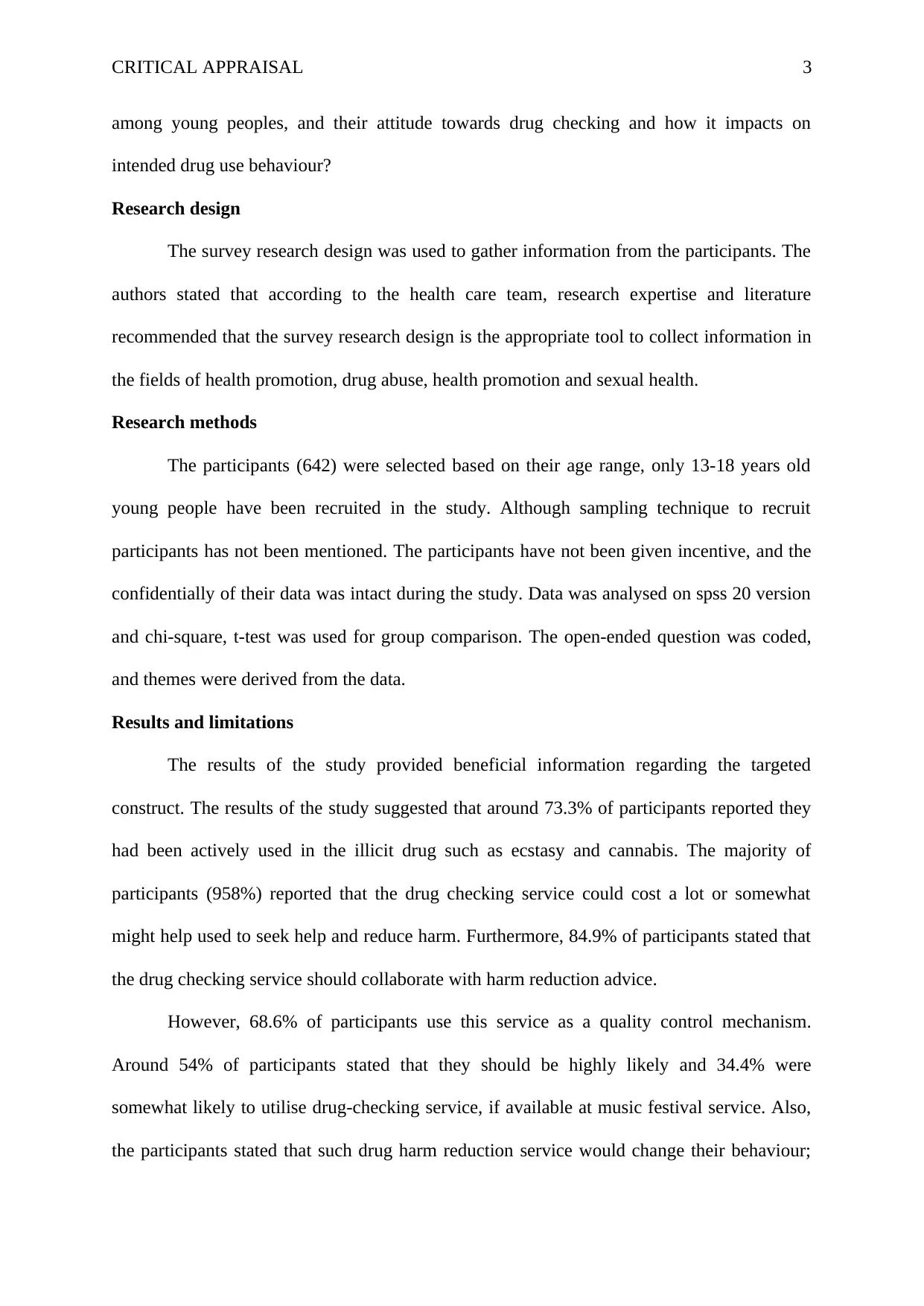
CRITICAL APPRAISAL 3
among young peoples, and their attitude towards drug checking and how it impacts on
intended drug use behaviour?
Research design
The survey research design was used to gather information from the participants. The
authors stated that according to the health care team, research expertise and literature
recommended that the survey research design is the appropriate tool to collect information in
the fields of health promotion, drug abuse, health promotion and sexual health.
Research methods
The participants (642) were selected based on their age range, only 13-18 years old
young people have been recruited in the study. Although sampling technique to recruit
participants has not been mentioned. The participants have not been given incentive, and the
confidentially of their data was intact during the study. Data was analysed on spss 20 version
and chi-square, t-test was used for group comparison. The open-ended question was coded,
and themes were derived from the data.
Results and limitations
The results of the study provided beneficial information regarding the targeted
construct. The results of the study suggested that around 73.3% of participants reported they
had been actively used in the illicit drug such as ecstasy and cannabis. The majority of
participants (958%) reported that the drug checking service could cost a lot or somewhat
might help used to seek help and reduce harm. Furthermore, 84.9% of participants stated that
the drug checking service should collaborate with harm reduction advice.
However, 68.6% of participants use this service as a quality control mechanism.
Around 54% of participants stated that they should be highly likely and 34.4% were
somewhat likely to utilise drug-checking service, if available at music festival service. Also,
the participants stated that such drug harm reduction service would change their behaviour;
among young peoples, and their attitude towards drug checking and how it impacts on
intended drug use behaviour?
Research design
The survey research design was used to gather information from the participants. The
authors stated that according to the health care team, research expertise and literature
recommended that the survey research design is the appropriate tool to collect information in
the fields of health promotion, drug abuse, health promotion and sexual health.
Research methods
The participants (642) were selected based on their age range, only 13-18 years old
young people have been recruited in the study. Although sampling technique to recruit
participants has not been mentioned. The participants have not been given incentive, and the
confidentially of their data was intact during the study. Data was analysed on spss 20 version
and chi-square, t-test was used for group comparison. The open-ended question was coded,
and themes were derived from the data.
Results and limitations
The results of the study provided beneficial information regarding the targeted
construct. The results of the study suggested that around 73.3% of participants reported they
had been actively used in the illicit drug such as ecstasy and cannabis. The majority of
participants (958%) reported that the drug checking service could cost a lot or somewhat
might help used to seek help and reduce harm. Furthermore, 84.9% of participants stated that
the drug checking service should collaborate with harm reduction advice.
However, 68.6% of participants use this service as a quality control mechanism.
Around 54% of participants stated that they should be highly likely and 34.4% were
somewhat likely to utilise drug-checking service, if available at music festival service. Also,
the participants stated that such drug harm reduction service would change their behaviour;
⊘ This is a preview!⊘
Do you want full access?
Subscribe today to unlock all pages.

Trusted by 1+ million students worldwide
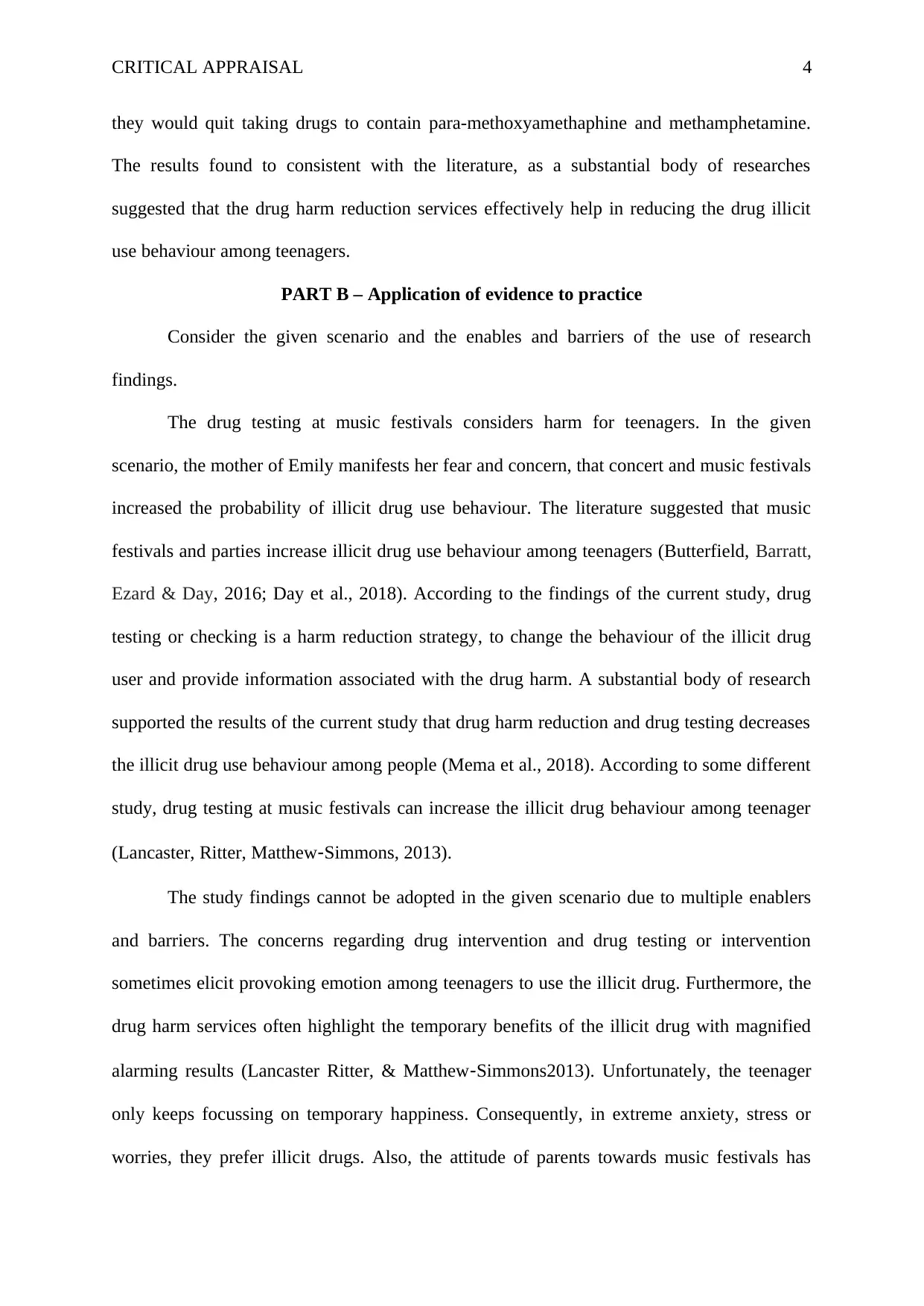
CRITICAL APPRAISAL 4
they would quit taking drugs to contain para-methoxyamethaphine and methamphetamine.
The results found to consistent with the literature, as a substantial body of researches
suggested that the drug harm reduction services effectively help in reducing the drug illicit
use behaviour among teenagers.
PART B – Application of evidence to practice
Consider the given scenario and the enables and barriers of the use of research
findings.
The drug testing at music festivals considers harm for teenagers. In the given
scenario, the mother of Emily manifests her fear and concern, that concert and music festivals
increased the probability of illicit drug use behaviour. The literature suggested that music
festivals and parties increase illicit drug use behaviour among teenagers (Butterfield, Barratt,
Ezard & Day, 2016; Day et al., 2018). According to the findings of the current study, drug
testing or checking is a harm reduction strategy, to change the behaviour of the illicit drug
user and provide information associated with the drug harm. A substantial body of research
supported the results of the current study that drug harm reduction and drug testing decreases
the illicit drug use behaviour among people (Mema et al., 2018). According to some different
study, drug testing at music festivals can increase the illicit drug behaviour among teenager
(Lancaster, Ritter, Matthew‐Simmons, 2013).
The study findings cannot be adopted in the given scenario due to multiple enablers
and barriers. The concerns regarding drug intervention and drug testing or intervention
sometimes elicit provoking emotion among teenagers to use the illicit drug. Furthermore, the
drug harm services often highlight the temporary benefits of the illicit drug with magnified
alarming results (Lancaster Ritter, & Matthew‐Simmons2013). Unfortunately, the teenager
only keeps focussing on temporary happiness. Consequently, in extreme anxiety, stress or
worries, they prefer illicit drugs. Also, the attitude of parents towards music festivals has
they would quit taking drugs to contain para-methoxyamethaphine and methamphetamine.
The results found to consistent with the literature, as a substantial body of researches
suggested that the drug harm reduction services effectively help in reducing the drug illicit
use behaviour among teenagers.
PART B – Application of evidence to practice
Consider the given scenario and the enables and barriers of the use of research
findings.
The drug testing at music festivals considers harm for teenagers. In the given
scenario, the mother of Emily manifests her fear and concern, that concert and music festivals
increased the probability of illicit drug use behaviour. The literature suggested that music
festivals and parties increase illicit drug use behaviour among teenagers (Butterfield, Barratt,
Ezard & Day, 2016; Day et al., 2018). According to the findings of the current study, drug
testing or checking is a harm reduction strategy, to change the behaviour of the illicit drug
user and provide information associated with the drug harm. A substantial body of research
supported the results of the current study that drug harm reduction and drug testing decreases
the illicit drug use behaviour among people (Mema et al., 2018). According to some different
study, drug testing at music festivals can increase the illicit drug behaviour among teenager
(Lancaster, Ritter, Matthew‐Simmons, 2013).
The study findings cannot be adopted in the given scenario due to multiple enablers
and barriers. The concerns regarding drug intervention and drug testing or intervention
sometimes elicit provoking emotion among teenagers to use the illicit drug. Furthermore, the
drug harm services often highlight the temporary benefits of the illicit drug with magnified
alarming results (Lancaster Ritter, & Matthew‐Simmons2013). Unfortunately, the teenager
only keeps focussing on temporary happiness. Consequently, in extreme anxiety, stress or
worries, they prefer illicit drugs. Also, the attitude of parents towards music festivals has
Paraphrase This Document
Need a fresh take? Get an instant paraphrase of this document with our AI Paraphraser
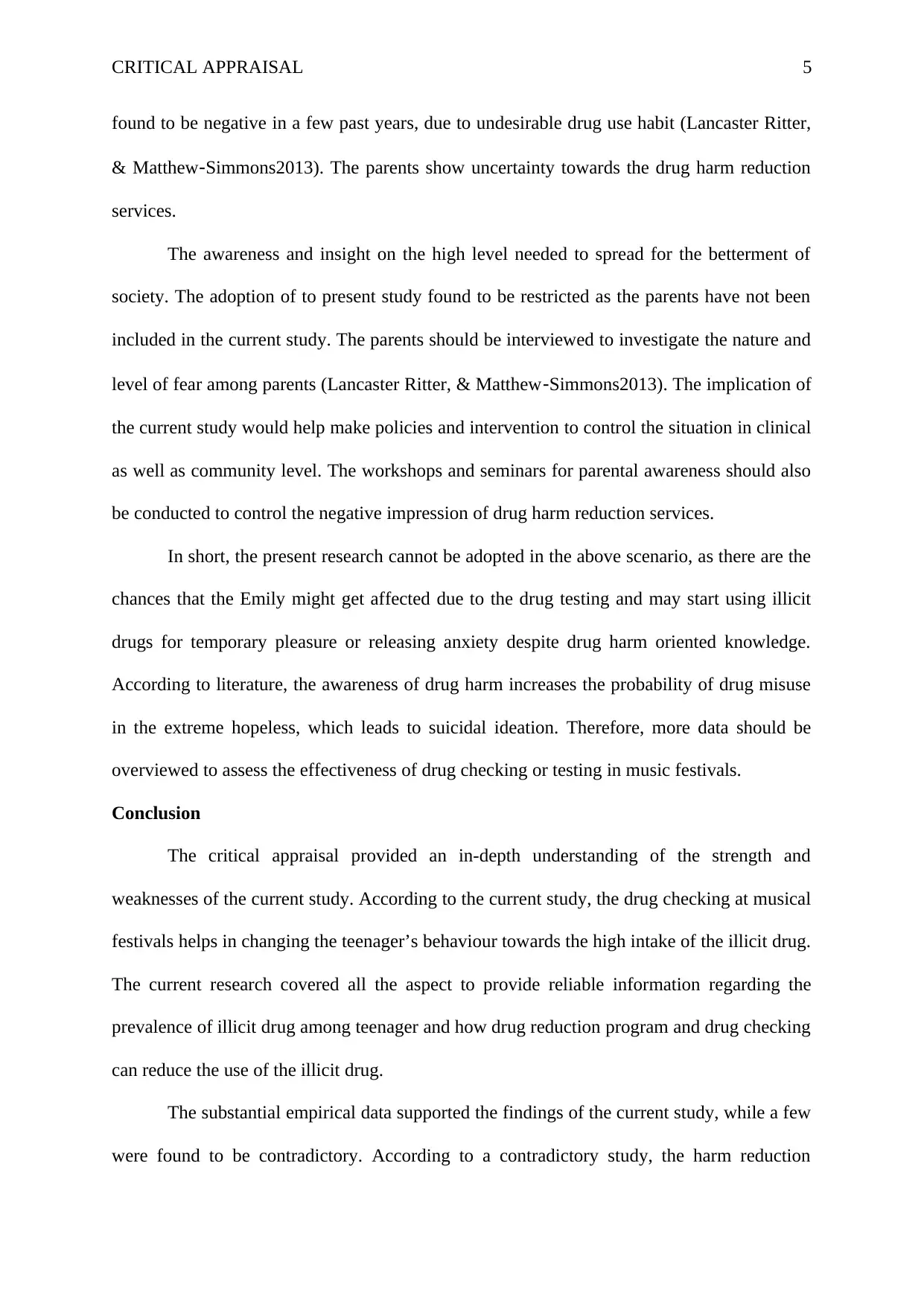
CRITICAL APPRAISAL 5
found to be negative in a few past years, due to undesirable drug use habit (Lancaster Ritter,
& Matthew‐Simmons2013). The parents show uncertainty towards the drug harm reduction
services.
The awareness and insight on the high level needed to spread for the betterment of
society. The adoption of to present study found to be restricted as the parents have not been
included in the current study. The parents should be interviewed to investigate the nature and
level of fear among parents (Lancaster Ritter, & Matthew‐Simmons2013). The implication of
the current study would help make policies and intervention to control the situation in clinical
as well as community level. The workshops and seminars for parental awareness should also
be conducted to control the negative impression of drug harm reduction services.
In short, the present research cannot be adopted in the above scenario, as there are the
chances that the Emily might get affected due to the drug testing and may start using illicit
drugs for temporary pleasure or releasing anxiety despite drug harm oriented knowledge.
According to literature, the awareness of drug harm increases the probability of drug misuse
in the extreme hopeless, which leads to suicidal ideation. Therefore, more data should be
overviewed to assess the effectiveness of drug checking or testing in music festivals.
Conclusion
The critical appraisal provided an in-depth understanding of the strength and
weaknesses of the current study. According to the current study, the drug checking at musical
festivals helps in changing the teenager’s behaviour towards the high intake of the illicit drug.
The current research covered all the aspect to provide reliable information regarding the
prevalence of illicit drug among teenager and how drug reduction program and drug checking
can reduce the use of the illicit drug.
The substantial empirical data supported the findings of the current study, while a few
were found to be contradictory. According to a contradictory study, the harm reduction
found to be negative in a few past years, due to undesirable drug use habit (Lancaster Ritter,
& Matthew‐Simmons2013). The parents show uncertainty towards the drug harm reduction
services.
The awareness and insight on the high level needed to spread for the betterment of
society. The adoption of to present study found to be restricted as the parents have not been
included in the current study. The parents should be interviewed to investigate the nature and
level of fear among parents (Lancaster Ritter, & Matthew‐Simmons2013). The implication of
the current study would help make policies and intervention to control the situation in clinical
as well as community level. The workshops and seminars for parental awareness should also
be conducted to control the negative impression of drug harm reduction services.
In short, the present research cannot be adopted in the above scenario, as there are the
chances that the Emily might get affected due to the drug testing and may start using illicit
drugs for temporary pleasure or releasing anxiety despite drug harm oriented knowledge.
According to literature, the awareness of drug harm increases the probability of drug misuse
in the extreme hopeless, which leads to suicidal ideation. Therefore, more data should be
overviewed to assess the effectiveness of drug checking or testing in music festivals.
Conclusion
The critical appraisal provided an in-depth understanding of the strength and
weaknesses of the current study. According to the current study, the drug checking at musical
festivals helps in changing the teenager’s behaviour towards the high intake of the illicit drug.
The current research covered all the aspect to provide reliable information regarding the
prevalence of illicit drug among teenager and how drug reduction program and drug checking
can reduce the use of the illicit drug.
The substantial empirical data supported the findings of the current study, while a few
were found to be contradictory. According to a contradictory study, the harm reduction
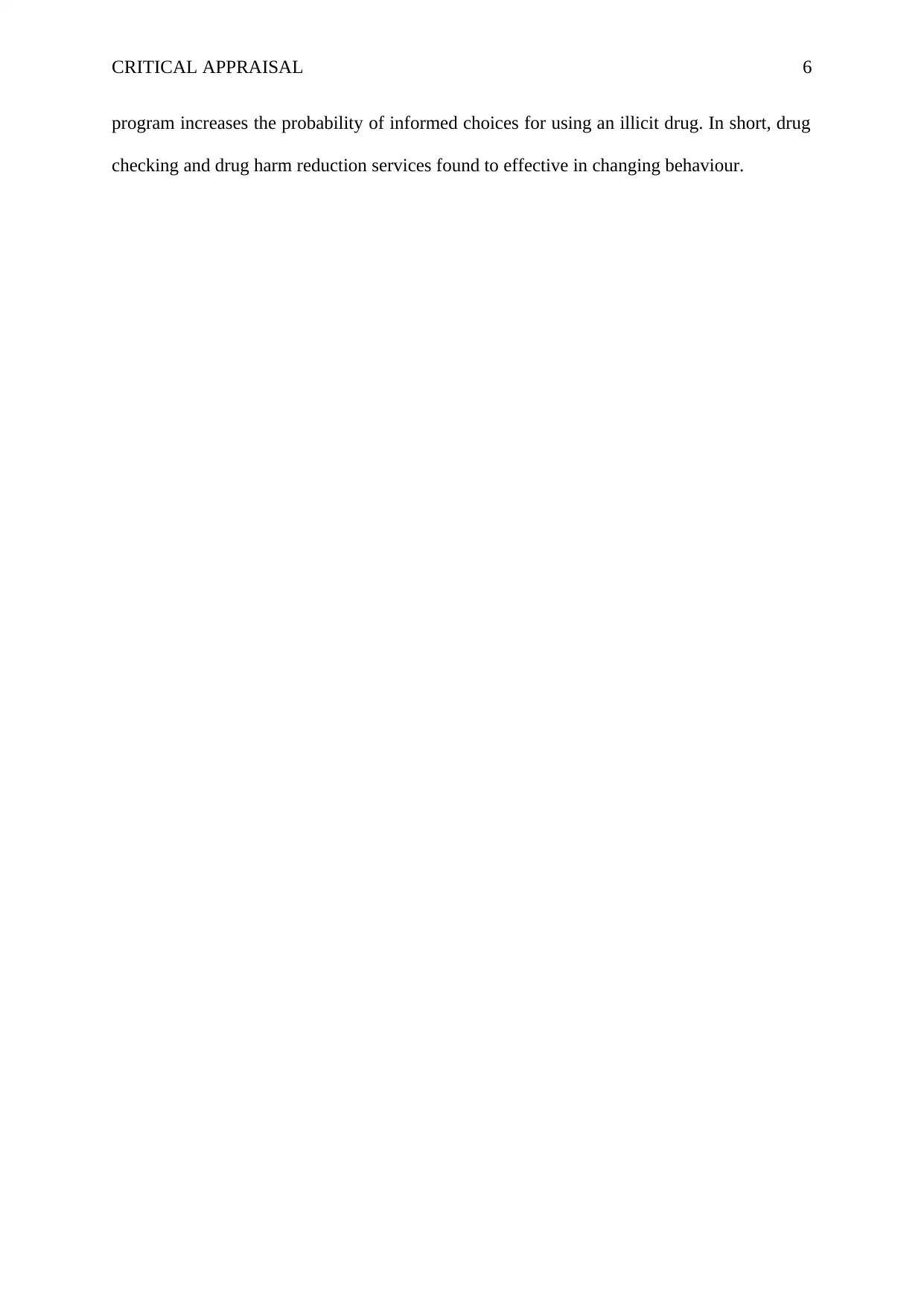
CRITICAL APPRAISAL 6
program increases the probability of informed choices for using an illicit drug. In short, drug
checking and drug harm reduction services found to effective in changing behaviour.
program increases the probability of informed choices for using an illicit drug. In short, drug
checking and drug harm reduction services found to effective in changing behaviour.
⊘ This is a preview!⊘
Do you want full access?
Subscribe today to unlock all pages.

Trusted by 1+ million students worldwide
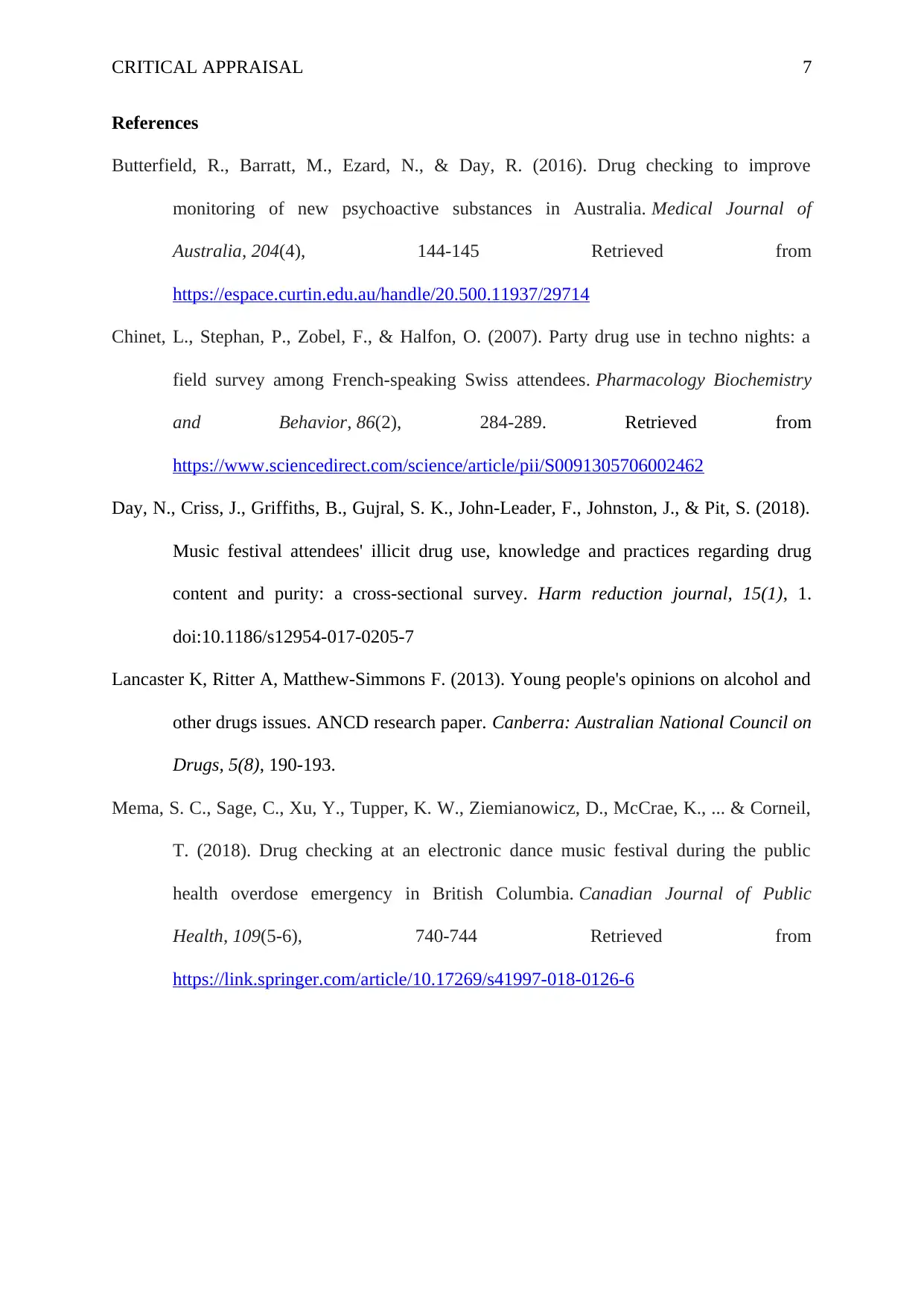
CRITICAL APPRAISAL 7
References
Butterfield, R., Barratt, M., Ezard, N., & Day, R. (2016). Drug checking to improve
monitoring of new psychoactive substances in Australia. Medical Journal of
Australia, 204(4), 144-145 Retrieved from
https://espace.curtin.edu.au/handle/20.500.11937/29714
Chinet, L., Stephan, P., Zobel, F., & Halfon, O. (2007). Party drug use in techno nights: a
field survey among French-speaking Swiss attendees. Pharmacology Biochemistry
and Behavior, 86(2), 284-289. Retrieved from
https://www.sciencedirect.com/science/article/pii/S0091305706002462
Day, N., Criss, J., Griffiths, B., Gujral, S. K., John-Leader, F., Johnston, J., & Pit, S. (2018).
Music festival attendees' illicit drug use, knowledge and practices regarding drug
content and purity: a cross-sectional survey. Harm reduction journal, 15(1), 1.
doi:10.1186/s12954-017-0205-7
Lancaster K, Ritter A, Matthew‐Simmons F. (2013). Young people's opinions on alcohol and
other drugs issues. ANCD research paper. Canberra: Australian National Council on
Drugs, 5(8), 190-193.
Mema, S. C., Sage, C., Xu, Y., Tupper, K. W., Ziemianowicz, D., McCrae, K., ... & Corneil,
T. (2018). Drug checking at an electronic dance music festival during the public
health overdose emergency in British Columbia. Canadian Journal of Public
Health, 109(5-6), 740-744 Retrieved from
https://link.springer.com/article/10.17269/s41997-018-0126-6
References
Butterfield, R., Barratt, M., Ezard, N., & Day, R. (2016). Drug checking to improve
monitoring of new psychoactive substances in Australia. Medical Journal of
Australia, 204(4), 144-145 Retrieved from
https://espace.curtin.edu.au/handle/20.500.11937/29714
Chinet, L., Stephan, P., Zobel, F., & Halfon, O. (2007). Party drug use in techno nights: a
field survey among French-speaking Swiss attendees. Pharmacology Biochemistry
and Behavior, 86(2), 284-289. Retrieved from
https://www.sciencedirect.com/science/article/pii/S0091305706002462
Day, N., Criss, J., Griffiths, B., Gujral, S. K., John-Leader, F., Johnston, J., & Pit, S. (2018).
Music festival attendees' illicit drug use, knowledge and practices regarding drug
content and purity: a cross-sectional survey. Harm reduction journal, 15(1), 1.
doi:10.1186/s12954-017-0205-7
Lancaster K, Ritter A, Matthew‐Simmons F. (2013). Young people's opinions on alcohol and
other drugs issues. ANCD research paper. Canberra: Australian National Council on
Drugs, 5(8), 190-193.
Mema, S. C., Sage, C., Xu, Y., Tupper, K. W., Ziemianowicz, D., McCrae, K., ... & Corneil,
T. (2018). Drug checking at an electronic dance music festival during the public
health overdose emergency in British Columbia. Canadian Journal of Public
Health, 109(5-6), 740-744 Retrieved from
https://link.springer.com/article/10.17269/s41997-018-0126-6
1 out of 7
Related Documents
Your All-in-One AI-Powered Toolkit for Academic Success.
+13062052269
info@desklib.com
Available 24*7 on WhatsApp / Email
![[object Object]](/_next/static/media/star-bottom.7253800d.svg)
Unlock your academic potential
Copyright © 2020–2025 A2Z Services. All Rights Reserved. Developed and managed by ZUCOL.




